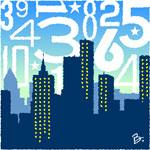The Fishbowl Effect: Getting Creative with Glass Houses
APRIL 16, 2009
As the popularity of glass curtain walls rises, architects and developers have become more innovative.
At 40 Bond Street, glass panes are supported by mullions held by green glass casings in homage to the building's original cast-iron frame. The exterior glass curtain wall at the Centria is made of a specially tinted glass that changes color depending on the light outside. Some of the largest single-pane windows ever used in a residential high-rise will be seen at Chelsea uber-condo HL23. Starchitect Jean Nouvel's 40 Mercer ups the ante with 12 stories of topaz-tinted triple-glazed windows.
Window functionality also comes in to play at several Manhattan buildings like the transparent window walls at 40 Mercer. Glass panels on lower floors slide out and down the curtain wall to create safety railings for residents. On the upper floors, massive glass panels slide horizontally along tracks to create open spaces of up to 20 feet. The apartments at 50 Franklin in Tribeca feature oversized windows with tilt/turn functionality and at Richard Meier's iconic 165 Charles Street, a computer-controlled layered shading system has been installed. The developers of Astor Place opted for aqua-tinted, highly reflective exterior glass to provide privacy. Even renovated buildings with more traditional windows, like Pearline Lofts in Tribeca–use motorized window shades to keep the vast triple-pane window glass in check.
ALSO IN NEW YORK CITY INSIDER
- 30 Park Place Vs. The Baccarat Hotel and Residences - JUL 8, 2014
- This Week in NYC Living - JUL 1, 2014
- Notable NYC Neighbors - JUN 26, 2014
- Great NYC Buildings: New in the Heights - JUN 23, 2014
- Notable NYC Neighbors - JUN 20, 2014
- Notable NYC Neighbors - JUN 17, 2014
- Building Vs. Building - JUN 9, 2014
- Notable NYC Neighbors - JUN 6, 2014
- Notable NYC Neighbors - MAY 23, 2014
- Notable NYC Neighbors - MAY 15, 2014
- Great NYC Apartment Buildings: 12 East 13th Street vs. 22 Central Park South - MAY 13, 2014
- Notable NYC Neighbors - MAY 7, 2014
- Notable NYC Neighbors - MAY 1, 2014
- Upping the Architectural Ante in NoHo - APR 22, 2014
- Great NYC Buildings: Brooklyn's Gold Coast Living - APR 15, 2014
- Notable NYC Neighbors - APR 11, 2014
- Building vs. Building - APR 10, 2014
- Notable NYC Neighbors - APR 2, 2014
- This Week in NYC Living - APR 1, 2014
- Notable NYC Neighbors - MAR 26, 2014
- View Articles By Date


 6sqft delivers the latest on real estate, architecture, and design, straight from New York City.
6sqft delivers the latest on real estate, architecture, and design, straight from New York City.
